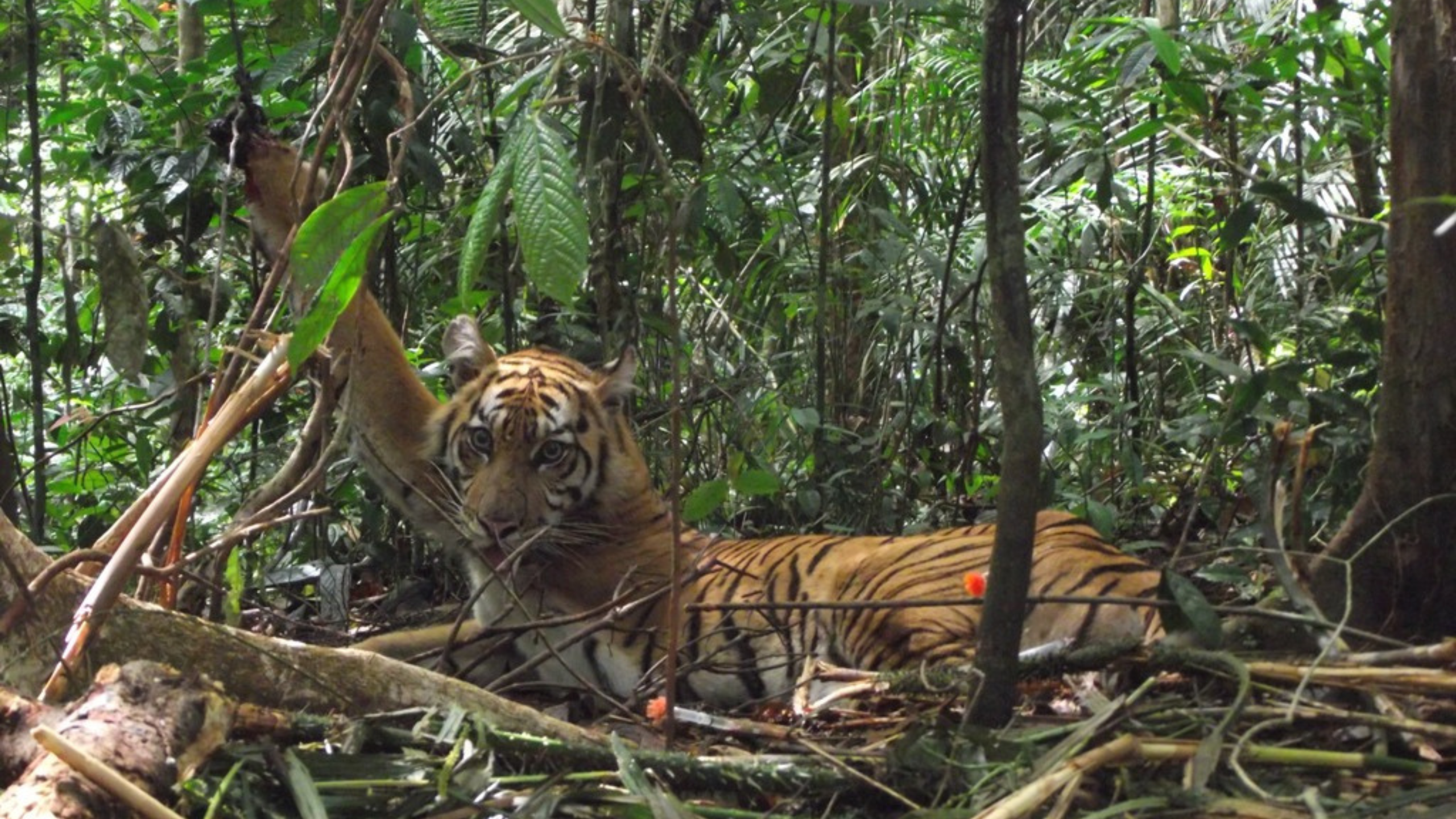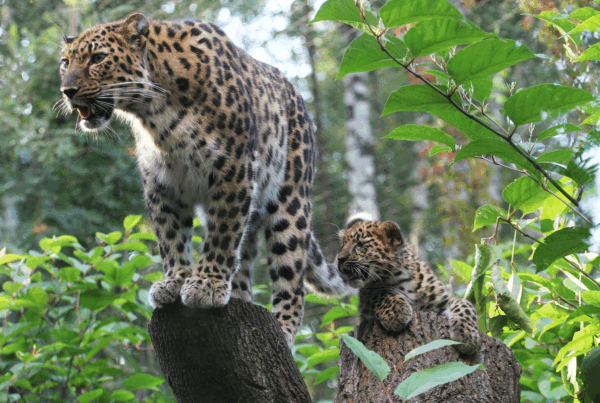- Snares, often targeting prey species like deer and wild boar, are indiscriminate traps causing immense suffering. Heavy-duty snares also target big cats for the illegal wildlife trade, impacting their survival and causing prolonged suffering.
- Adequate ranger patrols, prompt veterinary care, and training opportunities for veterinarians are crucial for mitigating the impact of snares on wildlife. Poverty alleviation and supporting farmers with alternative crop protection methods are essential for reducing reliance on poaching.
- Building alliances with local communities enhances anti-poaching efforts. Engaging locals as informants and employing them as rangers fosters trust and boosts morale. Collaboration is key to the long-term recovery of big cat populations.
Snaring Explained
A snare is a long piece of wire or rope attached to a tree with a loop at the end which catches an animal by the neck or leg as it is passing. Once caught, they panic and continue to pull at the snare making it tighter and tighter. If the snare is around their neck and strong enough, the animal will suffocate. Alternatively, if it is around their leg, they are trapped and can starve to death.
There are several categories of people, with varying intent, involved in snaring. The first two groups include farmers attempting to control wild boar in agricultural areas and deer hunters who operate in the forests. The third group, poachers, pursues tigers and leopards for profit. The target species of each of these groups can be determined by several characteristics of the snare such as its material, diameter of the noose, habitat type, and positioning at the trap site. However, regardless of the design and target species, snares kill indiscriminately, accidentally catching non-target species as bycatch.
Snaring prey species
Small, thin snares made of wire and nylon rope are set low to the ground to ensnare deer and wild boar. These prey species are targeted to control crop raiding of agricultural lands and subsidise the protein intake of local people. Some of the world’s poorest communities can be driven to these actions by food insecurity. Access to wild animals is often the only source of protein available and a loss of agricultural yield can be devastating. Beyond subsistence, commercial motivations are also a driver of snaring as a source of income through the domestic market for bushmeat.
While snaring of prey species does not directly target big cats, it has devastating impacts on their survival. In practice, snares indiscriminately kill and maim animals of all species with tigers and leopards regularly caught in snares set for wild boar and deer. Furthermore, depleting the population of tiger prey species leads to cascading effects in the wider ecosystem, disrupting food chains, pollination, and seed dispersal.

Snares used in the illegal trade of big cats
There are however snares still being set purposely to entrap big cats to fuel the commercial, international illegal trade of wildlife. These snares are constructed of heavy-duty wire and metal cables, set higher up to accommodate the bigger size of the animal. The illegal global wildlife trade of big cats does not fulfil any essential consumption needs. Instead, this trade is a multi-billion-dollar market and one of the most lucrative transnational crimes involving networks of highly organised criminal syndicates.
Regardless of if a big cat was the primary target or not, they are disproportionately impacted. If they are lucky enough to break free the prognosis is still not optimistic. They either break the snare from its base with the loop still attached to them causing constant constriction, swelling and pain. Alternatively, tigers may pull and chew at the leg until they lose the limb and break free. Both scenarios will likely lead to a prolonged and painful death as the animal struggles with the resulting infection and a reduced food intake as they are unable to hunt. It can also cause an increase in human-wildlife conflict as the big cat turns to livestock, domestic animals, and humans as easier prey.

Solutions
The often-mountainous forests where the snares are cryptically placed pose a formidable challenge for locating the traps and knowing the true extent of the problem. What we do know is that they were the main cause of recent tiger extirpations in rainforests of mainland Southeast Asia and if we don’t act now, these traps could threaten the very future of tigers across their range.
Having adequate numbers of properly paid rangers with sufficient equipment is essential to provide immediate protection to endangered species and their wider ecosystems. Rangers often remove multiple snares a day on their patrols. They are also able to perform small scale wildlife first aid or alert a wildlife vet if there is an animal who needs de-snaring and medical attention.
There also needs to be greater training opportunities for veterinarians to facilitate successful tiger rescues from snares. Prompt veterinary attention can significantly improve the likelihood of recovery from snare entrapment for wildlife threatened by snares.
Beyond this immediate response to the problem, it is important to distinguish between the motivations for snaring to enable us to address the crises effectively. Due to the multifaceted nature of this issue, attention must also be focused on poverty alleviation to reduce the dependence on poaching for nutrition and livelihoods. Economic development can drive down the need for subsistence hunting as an essential protein source.
Additionally, farmers need support to protect their agricultural land from crop-raiding species using alternative methods which are more efficient and reduce bycatch. If an alternative option is available which doesn’t include setting traps, then both big cats and their prey are protected.
Working with not against local people fosters community alliances and collaboration and builds local knowledge networks. Often poachers working for the illegal wildlife trade are from outside of rural communities so if the local people feel like they can trust conservationists and law enforcement agencies they can act as reliable informants. Local reporting guiding the location and timing of patrols can significantly increase the efficiency of snare removal efforts. Furthermore, employment opportunities as rangers can boost morale and provide alternative sources of income for carefully selected people who may otherwise be likely to participate in snaring. Local antipoaching teams can also serve as direct links between local communities and government enforcement personnel. The extent to which these collaborations are implemented and maintained is likely to determine the persistence of tigers across their range.
Big cat populations have a chance of recovery when they have adequate safe space and food. By reducing the number of snares and increasing the numbers of prey animals we expect to see an increase in big cat numbers. This will have a long-term impact only with the collaboration of local people and so they must be involved in the process.
Anti-snaring Fundraising Campaign
Between the 18-25 April we will be partaking in the Big Give Green Match Fund. During this week you can help WildCats to remove lethal snares targeting big cats and their prey. Your donation helps to preserve ecosystems and protect these endangered predators. Together, let’s eliminate snares, securing a future where big cats roam free and people and wildlife can thrive safely side-by-side.





